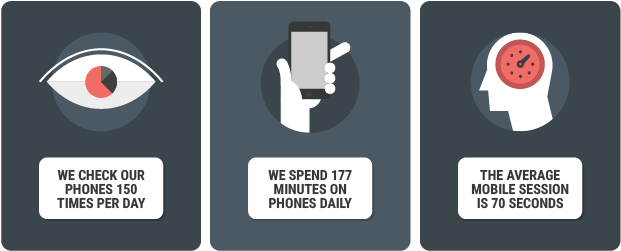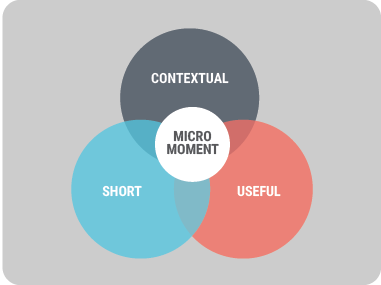Prepare for Your Journey
Learning Objectives
After completing this unit, you’ll be able to:
- Differentiate between mobile and desktop usage.
- Define the concept of micro-moments.
- List organizational changes that are critical for mobile transformation.
Know Before You Go
Even when you start small, a mobile journey is still a pretty big undertaking. It’s easy to get sidetracked by the prospect of arriving at an exciting destination and neglect the sometimes unglamorous work of preparation. Before embarking on any adventure, you have to be in the right frame of mind. So let’s prepare for our mobile journey by gearing up mentally.
Get in the Mobile Mind State
We can’t dive into the nuts and bolts of developing a mobile strategy until we tackle something a little more abstract: a shift in your mindset. But why is a mind shift so important?
To put it simply, mobile is different. And if your organization is new to mobility, it’s likely you have a certain set of assumptions about the mobile world based on your experiences with other online and digital channels.

But if you try to build a mobile strategy on top of those existing assumptions, you’ll ultimately fall short of your goal. That’s the equivalent of following a broken compass, or packing snow gear for a trip to Hawaii. So let’s make sure we’re thinking about mobile in the right way.
Mobile Is About Moments
When approaching mobile, many organizations make the mistake of trying to replicate their online experiences on the phone or tablet. It’s a bad idea, and here’s why: People interact with mobile devices much differently than computers.
Think about how many times a day you pick up your phone. Fifty? A hundred? In fact, according to an Internet Trends report, most people check their phones 150 times a day. And guess what else? Flurry Analytics found that users spend 177 minutes on their phones per day.

Do the math. That means the average mobile session is about 70-seconds long. Pretty mind-blowing, right? People interact with their phones in a series of brief and frequent bursts. Generally they’re trying to accomplish a specific task—like getting directions or checking their calendar—and they don’t have much time to do it before getting pulled away or distracted.
You can think of these interactions as micro-moments: the point in time when someone uses their phone in context to take a quick action or consume information. And on average, these bursts of focused activity last about a minute.
The Anatomy of a Micro-Moment
Now, don’t go discriminating against micro-moments because they’re so tiny. The short time span isn’t a limitation—it’s an opportunity! You have a chance to intercept your customers or employees at critical points during their day, anticipating their needs and helping them accomplish meaningful goals.
Micro-moments are powerful because they encourage a certain kind of interaction, one that is short, contextual, and useful.

- Short: The interaction is brief, simple, and focused. The time it takes to complete is generally no longer than a minute and a half.
- Contextual: The interaction happens in real time. What’s the user’s current situation? What are they doing now? What do they need? Where are they? Can you tap into their context using the unique hardware features of mobile devices, like the camera, microphone, compass, or accelerometer?
- Useful: The interaction is smart and relevant. You anticipate the user’s context and intent, and you deliver an interaction designed specifically for that moment.
If you can provide value to mobile users during these micro-moments, then you can win their business and loyalty—and maybe even their hearts and minds, too.
Examples of Micro-Moments
Now that you understand the concept of micro-moments, let’s look at a few examples. Here are some interactions that can deliver value to mobile users.
The User |
The Interaction |
|---|---|
Customer |
Reads helpful product reviews while shopping in your store to decide which item to purchase |
Customer |
Checks in at your store to unlock discounts or rewards |
Recruiter (employee) |
Enters notes about a prospective job candidate immediately after a meeting |
Service rep (employee) |
Looks up the next service call and gets directions to the location |
Tip: To help decision makers in your organization get into the mobile mindset, give them Google’s awesome resource, Micro-Moments: Your Guide to Winning the Shift to Mobile. There’s a link to it at the end of this unit.
Organize for Success
Now that you’re thinking about mobile in terms of micro-moments, you’ve begun to make the mobile mindshift. But we’ve barely scratched the surface. Mobility is more than a state of mind—it needs to run deeper than that. To achieve significant transformation, mobile must become part of your organization’s DNA.

As with any cultural shift, change starts at the top. For your mobile strategy to succeed, your executive team must recognize the value of mobile, formulate a vision, and pave the way for success. You’ll find that without executive support, many of your big mobile ideas will die on the vine. There won’t be enough budget. You’ll have trouble securing the right resources. You’ll bump up against organizational silos when you need to collaborate across departments or channels. And on and on.
If you want to reach your destination, your company needs to be organized for success. So how do you accomplish that?
Set the Right Course
We recommend that organizations establish a steering group that will be responsible for developing the overall mobile vision and strategy.

And who belongs in this group? It’s important to include executives who serve your customers as well as your employees because your mobile solutions ideally target both groups of users. And you also need IT leadership at the table because they typically own the technology resources and infrastructure. Here are some key members to tap for the committee:
- Chief information officer
- Chief marketing officer
- Chief operations officer
Depending on your company, your group can also include a business analyst, product experts, or representatives from key geographies. But keep the group as small as possible. You don’t want too many cooks in the kitchen when creating a mobile strategy.
Evaluate Your Mobile Maturity
Before you charge headfirst into the mobile wilderness, it would be nice to know whether your organization is prepared for the journey. So how do you assess your organization’s mobile readiness?
We recommend reading Forrester’s Mobile Mind Shift Maturity Framework report, which includes a comprehensive set of questions that can help you evaluate your company’s mobile maturity.
Pro tip: When you’re done reading the report, pass it along to key decision makers or stakeholders at your company.
OK...are you ready to make the mobile mindshift? Great! Hit the books and get crackin’ on your mobile homework. In the next unit, you learn how to craft a mobile strategy by identifying your organization’s goals and objectives.
Resources